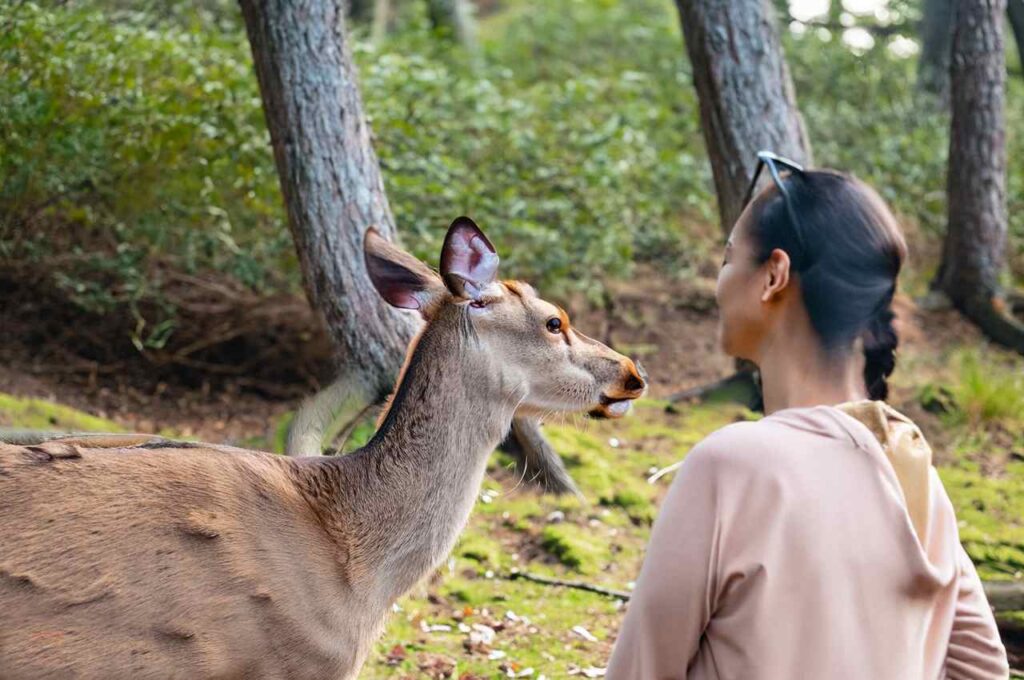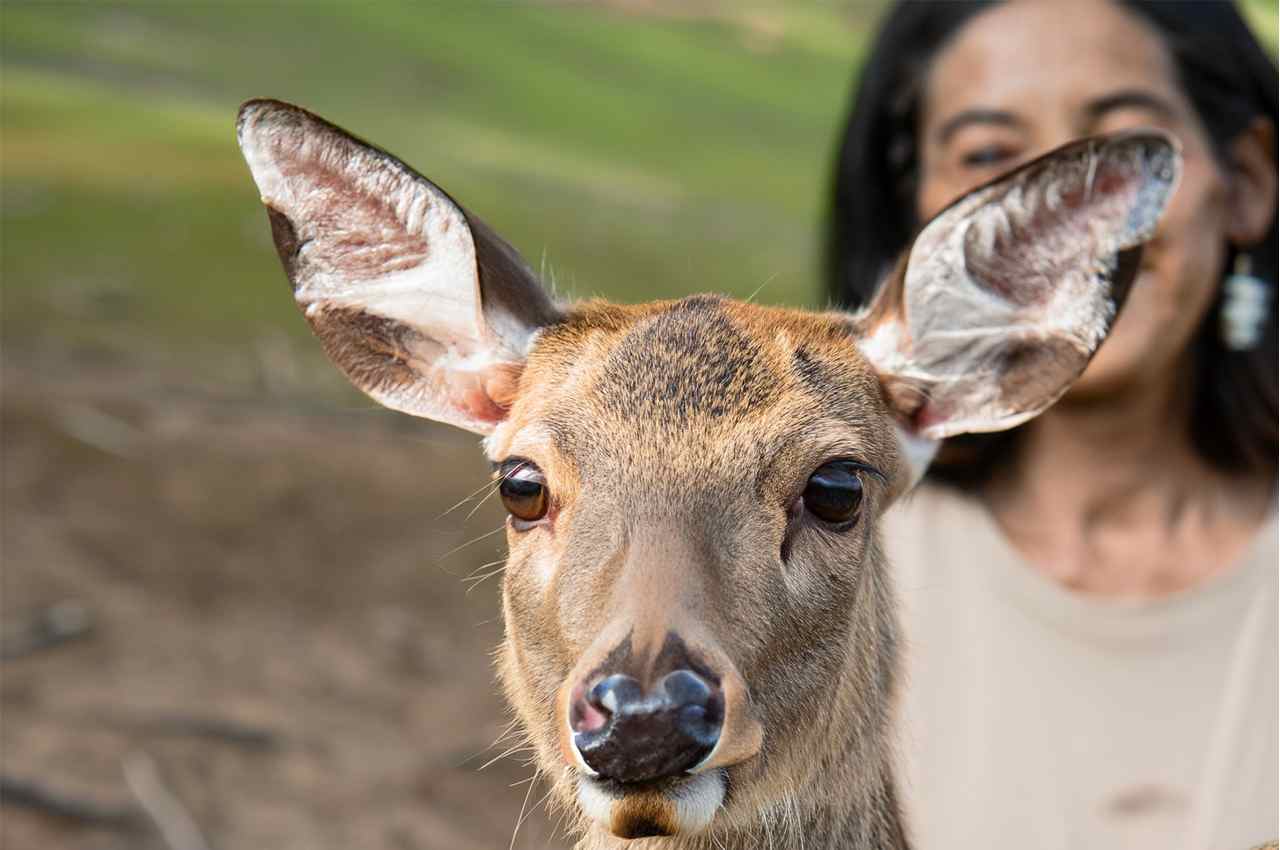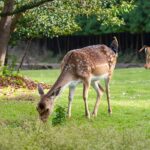To prevent conflicts with deer, it’s crucial to know, are deer friendly when they perceive a threat? Deer typically catch our interest about their goodwill towards people because of their elegant beauty and kind nature. People have a variety of opinions, and some even think of keeping deer as pets. We’ll explore the fascinating world of deer behavior in this investigation, examining whether or not they may be thought of as friendly and how to interpret their conduct when we come into contact with them in the wild.
Are Deer Friendly?
Generally speaking, deer are not thought of as sociable creatures. Because they are wild creatures, they naturally fear people. Deer have, however, sometimes become used to people and grown more accepting of their presence. This is more likely to occur in places like parks or neighborhoods where people often feed deer.
It’s crucial to keep in mind that deer are still wild animals and may be unpredictable, even if they seem friendly. It’s crucial to be cautious and respectful to every deer.

Deer Behavior Towards Humans
| Aspect | Description |
|---|---|
| Friendliness | Due of their fear of predators, deer avoid people. |
| Habituation | Deer in human-populated places may develop acclimated to humans but are still wild. |
| Petting | Petting wild deer might cause unpredictable behavior and danger. |
| Taming and Training | As fawns, deer may be educated to be friendlier, but they're not domesticated. |
| Approach and Interaction | Deer may approach people if they link them with food or feel comfortable, but be cautious. |
The Natural Behavior of Deer
We must first examine the deer’s innate habits in order to determine if they are friendly to people. The Cervidae family, which includes a number of species, includes deer. Regardless of the species, these magnificent animals have a few common behavioral patterns.
Their cautious and wary demeanor is one distinguishing feature. As a survival technique to shield them from predators, including humans, this wariness has developed through time. Due to their engrained habits, deer often respond with trepidation when they approach us because they perceive us as a possible danger.
Are Deer Inherently Friendly?
Deer are not amicable to people in their native environment. Instead, they prefer to steer clear of people whenever they can. They act in this way because they see people as one of the main risks in their surroundings.
There are exceptions, however, and that must be understood. Deer could develop more acclimated to people’s presence in places like metropolitan neighborhoods where they interact with people on a regular basis. They could exhibit some tolerance but not open friendship in such circumstances.
Do Deer Have the Ability to Be Tamed?
It is possible to educate or tame a deer to be amiable toward people, but there are important factors to take into account. The best strategy is fostering a deer as a fawn from an early age and using positive reinforcement methods. Particularly captive deer may be taught to accept certain human presence.

It’s important to realize that taming a deer does not imply complete domestication. Even domesticated deer have wild impulses and habits, therefore they may not be as amiable as completely domesticated animals. Additionally, caring for a deer as a pet calls for knowledge, commitment, and adherence to regional wildlife laws.
Deer’s Interaction with Dogs
| Aspect | Description |
|---|---|
| Deer's Perception of Dogs | Deer generally perceive dogs as unfriendly and a potential threat, particularly when they pursue or corner them. |
| Risks of Dog-Chasing | Dogs should be leashed in deer regions because deer may chase them and injure them. |
| Exceptions | When does defend their young, deer may attack dogs, especially during fawning season. |
Do Deer Enjoy Interacting With Humans?
Deer often avoid human contact and don’t appreciate it. These are some of the main explanations:
Deer Are Prey Animals
Deer automatically see humans and other big creatures as possible predators since they are a prey species. Their innate need to protect themselves from predators drives them to do so. Even if a deer becomes acclimated to seeing people, it will still be frightened and avoid them.
Deer Are Not Domesticated
Over many years, domesticated animals like dogs and horses have been carefully developed to get along well with people. Without this innate inclination for forging social relationships with humans, deer remain wild creatures.
Deer Have Small Comfort Zones
Deer create distinct home ranges and have strong senses to stay out of strange places. Compared to domesticated pets, they have far lower comfort zones near people. At the least apparent danger, they could run away.
Deer Communicate Through Body Language
Deer communicate primarily via body language, like the majority of their target species. They are unable to comprehend human sounds, gestures, or facial emotions.
When Might Deer Tolerate Human Presence?
Deer may get more used to and accepting of people under specific conditions, such as:
In Urban Environments
Deer that reside in city parks or close to residential areas are often exposed to human activities beginning at a young age. They discover that frequent passersby are not a severe threat, and they modify their comfort zones appropriately. In the presence of people, these urban deer often seem calmer.
When Offered Food Rewards
Deer may link certain persons to pleasant events, like obtaining food. Over time, they can come to see that individual as an opportunity rather than a danger. However, it’s crucial to avoid feeding wild deer since this might eventually result in harmful behavior toward people.
In Managed Parks or Estates
Deer living in professionally run private parks, zoos, or gated estates become used to the regular human activity from park staff or visitors. The deer have a comfortable attitude when there are few hazards present within the grounds.
When Sick, Injured, or Orphaned
When wounded, unwell, or abandoned as fawns, deer may sometimes approach people without running away. But rather than being kind, this tolerance is probably the result of illness, weakness, or disorientation. Deer in good health will continue to avoid contact.
Approaching a Deer Safely
Although it’s normally best to avoid approaching wild deer, there are certain circumstances when it could be necessary, such as during study or conservation efforts. If you ever need to go close to a deer, remember these precautions:
1. Move Slowly: Slowly approach the deer, being careful not to surprise it with unexpected movements or loud sounds.
2. Extend Your Hand: Make a non-threatening hand gesture to convey your good intentions. Allow the deer to watch your every move.
3. Respect Its Space: If the deer doesn’t run away and keeps its composure, you may slowly approach it. However, keep a respectable distance at all times, and be prepared to escape if the deer starts becoming upset.
4. Avoid Provocation: Do not in any way provoke or bother the deer. Keep in mind that you are a visitor on its land, therefore put its welfare first in whatever you do.
Reiterating that deer normally prefer alone and that one should approach them with extreme caution and respect for their natural habits is crucial.
Deer and Aggressions
Even while deer are often recognized for their kind nature, there have been reports of aggressiveness, especially among older bucks (male deer). It’s important to investigate the situations in which deer may act aggressively against people in order to understand these dynamics.
Most of the time, deer instinctively run away from people, particularly if they’re with fawns. When they feel threatened, females in particular act in a protective manner toward their young. Bucks, on the other hand, could act aggressively, particularly while mating or guarding their territory.
Understanding Deer Aggressive Behavior
Deer have certain actions that indicate their preparedness to protect themselves or their area when they become violent. These actions might be:
- Grunting: Aggressive deer may make grunting noises as a warning indication that they are uncomfortable or ready to defend themselves.
- Crouching: To look more frightening, an aggressive deer may lower itself into a crouching stance with its legs contracted.
- Hair Erection: A deer’s back hair may stand on end, giving the impression that they are bigger and more menacing.
- Antler Display: Adult bucks with antlers may point their heads in the direction of the imagined danger and stand ready to defend themselves with their antlers.
- Hoof Strikes: Deer have the ability to hit with their hooves, especially when they are standing on their hind legs.
When enraged, mature bucks constitute a significant physical danger because to their outstanding heights of approximately six feet and weights of over 200 pounds. When angered or trapped, their antlers make them very lethal.
What to Do When a Deer Attacks
Although deer assaults on people are relatively uncommon, it is nevertheless important to be ready and aware on how to react in such circumstances. Consider taking these actions if you encounter a hostile deer:
1. Create Distance: Try to move quietly and gently away from the deer to create some space between you and it. Refrain from ignoring it.
2. Use a Barrier: If one is available, place anything between you and the deer, such a pole or a rucksack.
3. Find Safety: If at all feasible, locate a secure area where you may seek shelter, such as a building or a vehicle. Deer cannot unlock doors or climb trees.
4. Fetal posture: Should a deer accidentally knock you to the ground, curl yourself into a fetal posture to protect your head and neck. Hold motionless until the deer gives up and walks away.
5. Antler Grab: In the worst-case situation, if the hostile buck keeps attacking, gripping its antlers and clinging to them firmly could stop any more damage. Once you release the antlers, the deer could resuming its assault, so be prepared to flee.
Pet Deer: A Complicated Matter
Although it may seem enticing to raise deer as pets, it’s important to comprehend the difficulties involved. The majority of deer kept as pets in the United States are ranch animals that are grown mainly for meat or for hunting in large preserves. Deer are sometimes kept as pets by private persons, nevertheless.
The muntjac deer, which is popular for its tiny size and adaptability for household settings, is one species that may be maintained as a house pet in specific circumstances. There are instances when individuals adopt abandoned wild white-tailed deer in places where it is acceptable to possess native deer. These deer may behave more like pets than wild animals when reared by people and domesticated from an early age.
Deer Species that may be considered as Pets
| Deer Species | Suitability as Pets | Additional Information |
|---|---|---|
| Muntjac Deer | Good indoor pets | Comparable in size to dogs, small and companionable. |
| Sitka (Sika) Deer | Suitable as pets | Possess a calm attitude and are sometimes kept as pets. |
| Axis Deer | Suitable as pets | Hunting favorites, raised on ranches for meat, and odd pets. |
| Reindeer | Domesticated species | used for a variety of functions in Arctic climates. |
| White-Tailed Deer | Potential but restricted | may make wonderful pets, but ownership is often prohibited in most regions. |
| Fallow Deer | Seen in zoos and parks | Deer that are adaptable and gentle, often seen in zoos, parks, and estates. |
Checking the legality of ownership in your region is essential when thinking about keeping deer as pets since local laws differ greatly. Additionally, there could be constraints due to health issues such chronic wasting disease (CWD).
Frequently Asked Questions
Are deer friendly to dogs?
In general, deer do not like dogs. They normally have an innate fear of predators, such as dogs, and would often flee if they come across one. Deer have, however, been known to attack dogs, particularly when the dog is pursuing the animal or the animal feels trapped. In deer-populated areas, leash your dog, avoid deer routes and feeding areas, and be ready to protect your dog if you encounter one. Additionally, it’s important to arrange routine veterinarian examinations for your dog and to get him vaccinated against illnesses that deer may carry.
Are baby deers friendly?

Baby deer, or fawns, are not typically considered friendly animals. Being wild, they are instinctively wary of humans and often hide to escape predators. Fawns in regions where people live can become more tolerant of people because of frequent feeding, but it’s important to keep in mind that they are still wild creatures and might behave in ways that are surprising. All fawns must be treated with respect and care due to their untamed nature.
What does it mean when a wild deer approaches you?
When a wild deer approaches you, it can indicate various reasons. Understanding the deer’s intents requires knowledge of both the environment and its behavior. Wild deer may approach out of curiosity, hunger, the need for medical attention for an injury, habituation to human presence, or, in rare instances, aggressiveness if they feel threatened or need to defend their young. It’s critical to maintain composure throughout these interactions, avoid making hasty moves, and evaluate the circumstances. Offer food if the deer looks hungry, gently move away, or call the neighborhood wildlife authority if the deer exhibits aggressive behavior or seems wounded.
Do Deer Show Affection Towards Humans?
With the exception of a few rare instances, there is no empirical proof that deer develop intimate social ties with people. Some actions that could seem friendly, like as nuzzling or licking salt off skin, are instead motivated by curiosity or mineral desires. Deer often don’t show any signs of affectionate behavior toward people.
Can I Keep a Deer as a Pet?
Deer are often not considered to be good pets. Even though some individuals foster abandoned fawns, adult deer are not good pets. They have certain requirements, and as they age, they may become hostile. Additionally, keeping a deer as a pet may be against the law in many places.
It is not advised to try to pet a wild deer and should be avoided. Wild deer lack the socialization and familiarity with human interaction that pets like dogs or cats do. They often retaliate with unpredictable and protective actions when approached or touched.
A wild deer as a pet is also immoral and neither feasible nor ethical. These creatures have intricate requirements and reflexes that work best in their native habitat. Numerous difficulties might arise while attempting to domesticate them, including destruction of property, disputes with other pets, and sporadic assaults on people.
Are Deer Friendly to Other Animals?
Deer seldom attack other animals unless they are protecting their young or their territory. They are known to cohabit with a variety of wild creatures, however they may stay away from others, such predators.
Why Do Some People Believe Deer Are Friendly?
Due to their frequent encounters in urban or suburban regions where deer have become acclimated to human presence, some people mistake deer for being friendly. Deer may look less wary in certain situations, giving the impression that they are kind.
Can I Hand-Feed Wild Deer?
Hand-feeding wild deer is typically not advised. Although it could seem like a kind gesture, it might be harmful to the deer and the habitat. It has the potential to change their natural behavior, render them reliant on human food, and contaminate deer herds with illnesses.
Do Deer Remember Humans?
Deer have an excellent recall and can identify certain individuals, particularly if they have done so often. However, just because they are recognized does not imply they automatically become amicable with others.
How to Safely Observe Deer in the Wild?
Maintain a respectful distance and steer clear of unexpected movements and loud sounds while watching deer in the wild to ensure your safety. To obtain a closer look at anything without disturbing them, use binoculars or a camera with a zoom lens.
Are Deer in Urban Areas Friendlier Than in the Wild?
Deer may seem more accepting of humans in metropolitan environments, although this is often due to familiarity rather than genuine friendliness. Although they have developed a tolerance for people’s presence, they still prefer to keep a safe distance.
Can You Train a Wild Deer to Behave Friendly?
It may be difficult to get a wild deer to behave well, and usually a fawn has to be raised from an early age. Even yet, they still have wild tendencies, thus encounters should be handled carefully.
Are There Any Friendly Deer Species?
Although each deer behaves differently, certain deer species, such as the fallow deer, are renowned for their adaptability and relative calmness. Although they should not be approached or handled like pets since they are still wild creatures.
How Can I Ensure My Safety Around Deer?
Keep a respectful distance, abstain from unexpected movements, and never approach deer in the wild to protect your safety near them. It’s important to keep in mind that although deer typically do not attack people, they may become combative if they feel threatened or trapped.
Conclusion
In conclusion, deer are not generally considered to be friendly animals. Because they are wild creatures, they naturally fear people. Deer have, however, sometimes become used to people and grown more accepting of their presence. This is more likely to occur in places like parks or neighborhoods where people often feed deer.
It’s crucial to keep in mind that deer are still wild animals and may be unpredictable, even if they seem friendly. It’s crucial to be cautious and respectful to every deer.
It’s also crucial to remember that deer could be carrying diseases that spread to humans as well as pets. It’s crucial to properly wash your hands after handling deer food or feces.
In general, it is advisable to admire deer from a distance and to stay away from them.
- California Deer Hunting Guide: Seasons, Rules, Permits, and More - 26 June 2024
- Arkansas Deer Season 2024 [Schedules, Licenses, Bag Limits & More!] - 26 June 2024
- 2024 Arizona Deer Season New Dates & Rules! - 25 June 2024




